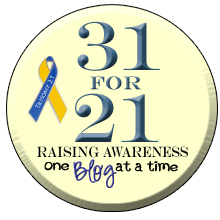Wednesday, October 6, 2010
Signs 31 for 21 Day 6
OK I'll admit I have a evil streak that runs deep at times. I received an email from Rachel at Signing Times today that made me giggle out loud.
Riley is a HUGE HUGE HUGE fan of Signing Times! We were lucky and my husband's family gave Riley a huge set of DVD's and CD's so while we have watch them a lot we had a bit of a selection to keep us from going crazy watching them over and over. Riley uses a lot of signs! Not as many now as he did a year a go but still a fair amount. He is replacing his signs with words just as we knew he would as he developed more words. Riley is adding words to his vocabulary daily. Daily he amazes us with new words and new sounds that he is adding to complete words that he has been approximating. I truly believe that Signing Times has been a large part of his development along with speech therapist Marie and tons of hard work from Riley!
To my critics that doubt that Sign language is great tool in language development I got a good giggle at your expense tonight as I was reminded yet again how amazing the Signing Times video series is!
The email newsletter had an article about about how Sign language can help children with Down syndrome develop language.
The use of ASL can open up the world of communication for children who have Down syndrome. There are three major ways that signs help these children develop language skills:
Signing makes communication possible – or easier
Some children with Down Syndrome may never learn to speak or to speak clearly. Signing gives them a way to express their needs, interests and preferences. For verbal children with articulation difficulties, signs make it easier for them to clarify spoken words.
Signing capitalizes on learning strengths
Children with Down syndrome are visual learners. Since sign language is a very visual form of communication, it naturally capitalizes on this learning strength.
Signing allows more time for processing
Children with Down syndrome often need more time to process verbal information. With signs, you can actually pause the hand shape and hold it in front of the child, or repeat the motion to give a child extra time needed to process the message.
They have also developed a guide that you can find here Signing Time Down syndrome guide
Subscribe to:
Post Comments (Atom)


I don't know how I got a day behind, but somehow I did.
ReplyDeleteI love that you did a post on this! I still get a little ruffled when I think of the stupid audacity of one who shall remain nameless. I mean, seriously, how does anyone look at signing as a negative? It's another form of communication, celebrate the awesomeness of that. I mean, hello, Riley is bi-lingual - This chick, yeah, I'm just "lingual," hee!hee!( :
Ah yes your critics....those were fun times : ) They really showed their asses and proved how little they know. Don't get me started....
ReplyDelete